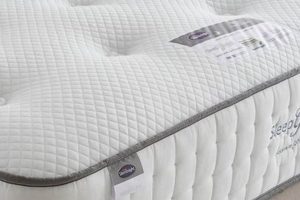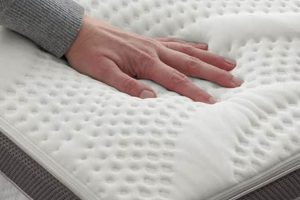The process of a compressed mattress regaining its full dimensions after being unpacked is referred to as expansion. This inflation period is essential for the mattress to achieve its intended comfort and support levels. A typical example is a memory foam mattress arriving rolled and vacuum-sealed, requiring a designated time to fully decompress and reach its designed thickness.
Allowing sufficient expansion time is crucial for several reasons. Premature use may impede the mattress’s ability to fully inflate, potentially impacting its long-term durability and overall performance. The structural integrity of the mattress relies on complete decompression of its materials. Furthermore, sleeping on an incompletely expanded mattress might lead to inconsistent support, affecting sleep quality and potentially causing discomfort.
The subsequent sections will delve into the recommended expansion times for various mattress types, the potential consequences of using a mattress before it is fully decompressed, and factors that can influence the expansion process. Additionally, guidance will be offered on how to optimize the expansion process to ensure the mattress achieves its full potential.
Guidance on Mattress Expansion and Use
The following provides critical guidance for ensuring optimal performance and longevity when dealing with mattresses that require expansion after delivery.
Tip 1: Adhere to Manufacturer’s Recommendations. Always consult the manufacturer’s instructions regarding the recommended expansion time. This period, usually expressed in hours or days, represents the time required for the mattress to fully decompress and reach its intended firmness and support levels. Deviating from these recommendations can compromise the mattress’s integrity.
Tip 2: Provide Adequate Ventilation. Unpacking the mattress in a well-ventilated room is crucial. This facilitates the dissipation of any residual odors from the manufacturing process or packaging materials. Additionally, proper airflow aids in the expansion process, particularly for foam-based mattresses.
Tip 3: Maintain a Suitable Ambient Temperature. Temperature significantly impacts the expansion rate of certain mattress materials, particularly memory foam. A moderate ambient temperature, generally between 68F and 72F (20C to 22C), provides an optimal environment for expansion. Extreme temperatures, whether hot or cold, can impede the process.
Tip 4: Avoid Applying Direct Pressure During Expansion. Refrain from placing heavy objects or applying significant pressure to the mattress while it is expanding. Such actions can disrupt the even distribution of materials and potentially create indentations or unevenness in the mattress surface.
Tip 5: Inspect the Mattress Thoroughly After Expansion. Once the recommended expansion time has elapsed, carefully inspect the mattress for any irregularities, such as uneven surfaces, sagging areas, or damaged seams. Addressing any issues promptly can prevent them from escalating into more significant problems.
Tip 6: Use a Supportive Foundation. Ensure the mattress is placed on a suitable foundation or bed frame that provides adequate support. An inappropriate foundation can hinder proper expansion and reduce the mattress’s overall lifespan. A solid platform bed or a slatted foundation with minimal spacing between slats is generally recommended.
Following these guidelines diligently will contribute significantly to maximizing the comfort, support, and longevity of a newly expanded mattress. These practices ensure the intended properties of the mattress are realized, providing an optimal sleep experience.
The next section will address potential issues that may arise during the expansion process and how to resolve them effectively.
1. Manufacturer Guidelines
Manufacturer guidelines represent the definitive source of information regarding the appropriate handling and use of a mattress during its expansion phase. These guidelines, typically provided in accompanying documentation or on the manufacturer’s website, specify the recommended time frame for full expansion and explicitly address whether use is permissible during this period. Deviating from these instructions can result in suboptimal mattress performance and potential warranty invalidation. For example, a memory foam mattress manufacturer might stipulate a 72-hour expansion period and explicitly state that using the mattress before this time may impede proper decompression and compromise support. Such a mandate is based on rigorous testing and designed to ensure the mattress performs as intended.
The importance of adhering to manufacturer guidelines stems from the inherent variability in mattress construction and materials. Different foam densities, layering configurations, and manufacturing processes can influence the expansion rate and the stability of the mattress during this critical phase. For instance, a hybrid mattress with both foam and innerspring components may require a longer or more specific expansion process compared to an all-foam model. Failing to follow these specified procedures may lead to uneven expansion, reduced support, or accelerated wear, particularly in the areas subjected to the most pressure during use.
In summary, manufacturer guidelines are integral to ensuring a mattress achieves its intended level of comfort and support. Disregarding these instructions introduces a significant risk of compromising the mattress’s integrity and voiding any warranty protections. Consumers are advised to prioritize careful review and strict adherence to these guidelines to maximize the long-term performance and value of their purchase. The manufacturers instructions are the primary consideration when determining whether use is appropriate during the expansion phase.
2. Material Composition
The material composition of a mattress directly influences its expansion characteristics and, consequently, the suitability of using it during the expansion process. Different materials exhibit varying degrees of elasticity and response to compression, affecting the time required for them to fully regain their intended shape and firmness. For instance, mattresses primarily composed of memory foam tend to require a more extended expansion period compared to those made of innerspring coils. This is attributable to memory foam’s viscoelastic properties, which cause it to slowly return to its original form after being compressed for shipping and storage. Using a memory foam mattress prematurely, before full expansion, may result in inconsistent support distribution and compromise the material’s long-term structural integrity.
Latex mattresses, whether natural or synthetic, also demonstrate specific expansion behaviors. Natural latex, known for its resilience and responsiveness, typically expands more rapidly than memory foam. However, even with quicker expansion, premature use could still impact its ability to uniformly settle and provide optimal support across the entire surface. Innerspring mattresses, while possessing coils that readily regain shape, often incorporate comfort layers made of foam or fiber. The expansion of these supplementary materials must also be considered, as their incomplete decompression can affect the overall comfort and pressure relief offered by the mattress. Hybrid mattresses, which combine multiple material types, present a more complex scenario where the expansion characteristics of each component influence the overall process. Manufacturers carefully balance these material properties during design to predict and manage expansion behavior, making adherence to specified expansion times essential.
In conclusion, the choice of materials in a mattress is not merely a matter of comfort preference; it is a critical factor determining the expansion process and the appropriateness of using the mattress during that process. Recognizing the unique expansion properties of different materials is paramount for ensuring the mattress achieves its full potential in terms of support, comfort, and longevity. Ignoring these material-specific requirements can lead to compromised performance and a diminished sleep experience. The interaction between material composition and expansion necessitates careful attention to manufacturer recommendations to ensure proper decompression and optimal mattress function.
3. Expansion Timeline
The expansion timeline represents the duration required for a compressed mattress to reach its full dimensions and intended firmness. This duration is intrinsically linked to whether using the mattress during expansion is advisable. The timeline varies significantly based on the mattress type and its constituent materials. Memory foam mattresses, for instance, generally require a longer expansion period compared to innerspring models. Using a mattress prematurely short-circuits this process, potentially preventing the materials from fully decompressing. This incomplete expansion can lead to uneven support, reduced comfort, and potentially compromise the mattress’s structural integrity over time. For example, a memory foam mattress compressed for shipping may require 48-72 hours to fully expand. Sleeping on it before this period may result in body impressions forming prematurely and uneven settling of the foam layers.
Furthermore, the ambient temperature and humidity levels can influence the expansion timeline. Colder temperatures can slow down the expansion process, whereas warmer temperatures may accelerate it. This environmental influence underscores the importance of following manufacturer recommendations, as these typically account for a range of environmental conditions. Consider a latex mattress, which, although generally quicker to expand than memory foam, may still be affected by colder temperatures. Its elasticity could be temporarily reduced, impacting the uniformity of its expansion. In such cases, attempting to sleep on the mattress before it has fully adjusted to the ambient temperature could lead to discomfort and diminished support.
In summary, the expansion timeline is a critical determinant of whether a mattress is suitable for use immediately after unpacking. Adhering to the manufacturer’s specified expansion period is essential for ensuring the mattress achieves its intended performance characteristics and maintains its structural integrity. Ignoring this timeline introduces the risk of compromised comfort, diminished support, and potentially shortened lifespan of the product. The expansion timeline, therefore, acts as a crucial parameter in the overall assessment of when a mattress is ready for use.
4. Support Integrity
Support integrity, in the context of mattresses that require expansion, refers to the ability of the mattress to provide consistent and uniform support across its surface. This is crucial for maintaining proper spinal alignment and preventing pressure points during sleep. Compromised support integrity during the expansion phase can lead to discomfort, poor sleep quality, and potentially long-term musculoskeletal issues. The following details delineate key facets of support integrity in relation to mattress expansion.
- Uniformity of Decompression
A mattresss capacity for uniform decompression directly affects its support integrity. If certain areas expand more quickly or fully than others, the result is an uneven sleep surface. For instance, if the edges of a mattress fully expand while the center remains compressed, the sleeper may experience a sensation of rolling towards the edge, compromising spinal alignment. This unevenness can exacerbate pressure points and disrupt sleep. A consistent decompression rate is vital for achieving a uniform support profile.
- Material Density and Distribution
The density and distribution of the mattress’s internal materials significantly influence its ability to provide consistent support. Memory foam, for example, requires a specific time to reach its designed density and conforming properties. Premature use can inhibit this process, resulting in localized areas of insufficient support. Similarly, if the internal materials are not properly distributed during expansion, areas of high and low density can emerge, creating inconsistencies in support. A uniform material density is therefore essential for maintaining consistent support across the mattress.
- Coil System Stability (In Hybrid Mattresses)
In hybrid mattresses incorporating innerspring coil systems, the stability of these coils during expansion is paramount for support integrity. If the coil system is compressed or distorted during the initial expansion phase, it can lead to localized areas of reduced support and increased pressure. This is particularly relevant in mattresses that are tightly compressed for shipping. Ensuring the coil system regains its proper configuration is critical for preventing sagging and maintaining consistent support throughout the mattress’s lifespan. Stable coil systems are a must.
- Edge Support Considerations
Edge support is a critical aspect of overall support integrity. Mattresses with inadequate edge support tend to sag or compress excessively when weight is applied near the perimeter. This can create a feeling of instability and limit the usable sleep surface. During the expansion phase, the edge support components must fully decompress to provide the intended level of reinforcement. Premature use can prevent this, resulting in compromised edge support and reduced overall sleep quality. Therefore, fully expanded edge support is pivotal to consistent support.
These facets of support integrity illustrate why adhering to manufacturer recommendations regarding expansion time is essential. Using a mattress before it has fully expanded can compromise its ability to provide adequate and consistent support, leading to discomfort and potentially long-term issues. Therefore, prioritizing complete expansion is a vital step in ensuring the mattress delivers its intended benefits and provides a comfortable and supportive sleep environment.
5. Off-Gassing Concerns
The phenomenon of off-gassing is a relevant consideration when evaluating the appropriateness of using a mattress during its expansion period. Off-gassing refers to the release of volatile organic compounds (VOCs) from various materials, including foams, adhesives, and flame retardants commonly found in new mattresses. These VOCs, present in trace amounts, can emit odors and, in some individuals, trigger respiratory irritation or allergic reactions. The concentration of VOCs is typically highest during the initial expansion phase, gradually diminishing over time as the materials stabilize. Therefore, premature use of a mattress during this period can lead to increased exposure to these compounds. For example, a memory foam mattress, known for its dense composition, may exhibit a more pronounced off-gassing effect compared to a traditional innerspring mattress. Sleeping on it before the VOCs have adequately dissipated can result in heightened odor sensitivity and potential health concerns, particularly for individuals with pre-existing respiratory conditions or chemical sensitivities.
Proper ventilation plays a crucial role in mitigating off-gassing concerns. Allowing the mattress to expand in a well-ventilated room facilitates the dispersion of VOCs into the surrounding environment, accelerating the reduction of their concentration. This proactive approach minimizes the potential for inhalation and subsequent adverse effects. Real-world examples include consumers airing out new mattresses for several days before use, often placing them near open windows or using air purifiers to enhance ventilation. Furthermore, the type of materials used in mattress construction significantly impacts the severity of off-gassing. Mattresses made with natural or certified organic materials, such as natural latex or organic cotton, tend to exhibit lower levels of VOC emissions compared to those containing synthetic foams and chemical treatments. The practical significance of understanding this connection lies in empowering consumers to make informed choices about mattress materials and ventilation practices to minimize potential health risks.
In summary, off-gassing is a valid concern when determining whether to use a mattress during its expansion phase. The release of VOCs from new mattresses can pose potential health risks, particularly for sensitive individuals. Prioritizing proper ventilation and selecting mattresses made with low-VOC materials are effective strategies for mitigating these concerns. Adherence to manufacturer guidelines regarding expansion time further minimizes the risk of prolonged exposure to off-gassing compounds. The mitigation of these concerns ensures a healthier and more comfortable sleep environment.
6. Comfort Level
Comfort level serves as a crucial gauge in determining the suitability of using a mattress during its expansion phase. It reflects the subjective experience of the user regarding the mattress’s feel and support. A compromised comfort level can indicate that the mattress has not yet fully achieved its intended properties, potentially leading to disrupted sleep and discomfort.
- Surface Firmness and Conformity
The surface firmness and conformity of a mattress directly correlate with perceived comfort. If the mattress has not fully expanded, its surface may feel uneven or lack the desired level of contouring to the body. For instance, a memory foam mattress that is not fully decompressed may exhibit localized hard spots or a general lack of responsiveness to pressure. This can result in pressure points and a diminished sense of cradling, negatively affecting sleep quality. The intended level of surface firmness is often not reached until the prescribed expansion period is complete.
- Support Layer Engagement
The support layer, responsible for providing underlying structural support and spinal alignment, must fully engage to deliver optimal comfort. If the support layer remains compressed, the mattress may lack the necessary stability and lead to sagging or an unstable sleep surface. Consider a hybrid mattress with a coil support system; if the coils are still partially compressed, they may not provide adequate support, leading to back pain and discomfort. This lack of full engagement compromises the intended comfort profile of the mattress.
- Temperature Regulation Properties
Certain mattress materials, such as gel-infused memory foam or open-cell latex, are designed to regulate temperature and enhance sleep comfort. However, these properties may not be fully realized until the mattress has completely expanded and the materials have settled. For example, if a gel-infused memory foam mattress is used prematurely, the gel particles may not be evenly distributed, resulting in inconsistent temperature regulation and potential overheating. Proper material settling is essential for achieving the intended temperature regulation benefits.
- Pressure Relief Distribution
The ability of a mattress to evenly distribute pressure and relieve pressure points is paramount for comfort. Incomplete expansion can lead to localized pressure concentrations, particularly in areas such as the shoulders and hips. This is exemplified by a mattress with partially expanded comfort layers; these layers may not adequately conform to the body, resulting in increased pressure on these sensitive areas and potential discomfort. Adequate pressure relief is often only achieved after full material decompression and stabilization.
The facets of comfort levelsurface firmness, support layer engagement, temperature regulation, and pressure relief distributioncollectively underscore the importance of allowing a mattress to fully expand before use. Compromised comfort serves as a tangible indicator that the mattress has not yet achieved its intended properties, potentially resulting in a suboptimal sleep experience. Paying attention to the felt comfort level provides a practical gauge for determining when a mattress is truly ready for use.
7. Warranty Implications
Warranty implications are a critical consideration when addressing the suitability of using a mattress during its expansion phase. Mattress warranties, provided by manufacturers, often stipulate specific conditions that must be met to maintain coverage. Deviating from these conditions, such as using the mattress prematurely, can inadvertently void the warranty, leaving the consumer without recourse in the event of subsequent defects or performance issues.
- Adherence to Expansion Guidelines
Most mattress warranties explicitly require adherence to the manufacturer’s guidelines regarding expansion time. These guidelines outline the recommended period for allowing the mattress to fully decompress and achieve its intended firmness. Failure to comply with these instructions can be interpreted as misuse or improper handling of the product, thereby invalidating the warranty. For example, a warranty may state that using a mattress before the recommended 72-hour expansion period voids coverage for sagging or uneven support.
- Foundation Requirements During Expansion
Some warranties stipulate specific foundation requirements during the expansion phase. This may include using a solid platform bed or a slatted foundation with specific slat spacing. Using an improper foundation during expansion can compromise the mattress’s structural integrity and may be deemed a violation of the warranty terms. A warranty clause might state that using a foundation with inadequate support during expansion voids coverage for deformities or structural failures.
- Documentation of Proper Expansion Procedures
In some instances, manufacturers may require documentation demonstrating that the consumer followed proper expansion procedures. This could involve retaining packaging materials, photographing the mattress at various stages of expansion, or providing proof of purchase date. The absence of such documentation can hinder warranty claims, particularly if issues arise that could be attributed to improper expansion. For instance, if a mattress develops uneven compression, the manufacturer might request documentation verifying that the recommended expansion period was observed.
- Impact of Premature Use on Material Integrity
Warranties often cover defects in materials or workmanship. However, damage resulting from premature use of a mattress during expansion may not be covered. This is because using a mattress before it has fully expanded can compromise its material integrity, leading to premature wear, sagging, or uneven support. A warranty claim for a sagging mattress might be denied if evidence suggests that the mattress was used before it had fully expanded and conformed to its intended shape and density.
These warranty implications underscore the importance of carefully adhering to manufacturer instructions regarding mattress expansion. Failing to do so can result in the inadvertent voiding of warranty coverage, leaving the consumer financially responsible for any subsequent repairs or replacements. Prioritizing proper expansion procedures safeguards the consumer’s investment and ensures access to warranty protection in the event of product defects.
Frequently Asked Questions
The following addresses common inquiries regarding the appropriate use of mattresses that require expansion after delivery. Information is provided to clarify best practices and potential implications of deviation from recommended procedures.
Question 1: Is it permissible to sleep on a compressed mattress immediately after unboxing?
Generally, it is not recommended to sleep on a mattress immediately after unboxing if it has been compressed for shipping. These mattresses require a specific expansion period to achieve their intended firmness and support characteristics. Refer to the manufacturers instructions for the recommended timeframe.
Question 2: What factors influence the mattress expansion timeline?
Several factors influence the mattress expansion timeline, including the type of material used (e.g., memory foam, latex, innerspring), the density of the foam layers, and the ambient temperature. Colder temperatures may slow down the expansion process.
Question 3: What potential issues may arise from premature use of a mattress undergoing expansion?
Premature use of a mattress during expansion can lead to several issues, including uneven support, reduced comfort, and potential damage to the mattresss internal structure. The mattress may not fully decompress, resulting in compromised performance and potential long-term durability concerns.
Question 4: How does mattress material composition affect the appropriateness of sleeping on it during expansion?
The material composition plays a significant role. Memory foam mattresses, known for their viscoelastic properties, require more extended expansion periods than innerspring mattresses. Using a memory foam mattress before full expansion may compromise its support integrity. Latex mattresses typically expand more quickly but still require adequate time to settle uniformly.
Question 5: What is the significance of manufacturer guidelines regarding mattress expansion?
Manufacturer guidelines are paramount. These guidelines outline the recommended expansion time and any specific instructions for ensuring proper decompression. Deviating from these instructions can void the warranty and lead to suboptimal mattress performance. Adherence to these guidelines is crucial for maximizing the mattresss lifespan and achieving its intended level of comfort.
Question 6: Does premature use of a mattress during expansion impact the warranty coverage?
Yes, premature use can impact warranty coverage. Most mattress warranties stipulate adherence to the manufacturers expansion guidelines. Failure to comply with these guidelines may be interpreted as improper use, thereby voiding the warranty in case of subsequent defects or performance issues.
Proper mattress expansion is vital to achieving the product’s optimal comfort, support, and longevity. Ignoring manufacturer recommendations can lead to suboptimal outcomes and potential warranty complications.
The next section will discuss strategies for optimizing the mattress expansion process.
“Can You Sleep on a Mattress While Its Expanding”
This exploration of whether it is appropriate to sleep on a mattress while it is expanding underscores the importance of adhering to manufacturer guidelines and considering material composition. Premature use can compromise support integrity, exacerbate off-gassing concerns, diminish comfort levels, and potentially void warranty coverage. The expansion timeline is a critical determinant, varying based on mattress type and environmental conditions. Uniform decompression, adequate ventilation, and proper foundation support are essential for optimizing mattress performance.
In summation, exercising patience during the expansion phase proves prudent. A commitment to fully decompressing a mattress before use ensures the product achieves its intended design characteristics, delivers optimal support and comfort, and potentially prolongs its lifespan. This dedication to proper procedures represents an investment in long-term sleep quality and overall mattress value. Prioritizing the manufacturer’s recommendations and allowing the mattress to completely expand becomes essential for a well-supported and restful sleep.







